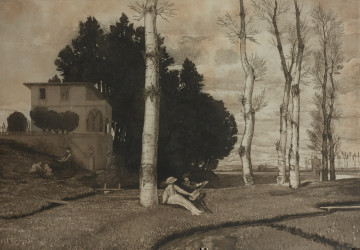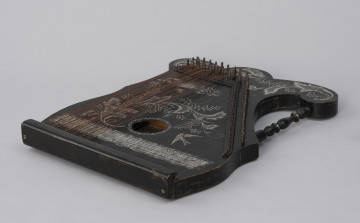
Symbolic scene
1890
National Museum in Szczecin
Part of the collection: Dutch and Flemish graphics
Hendrik Liberti (1600-1669), composer and organ virtuoso, was the organist of the cathedral in Antwerp from 1630 to 1661, where he chose to live to escape the religious conflict between Protestants and Catholics. In the engraving after the painting by Anthon van Dyck (1599-1641), the musician is presented in a half-length, his young and plump face framed with light locks, a prominent triple chain – a sign of his status and achievements – flowing from his arm over his nonchalant clothes. In his right hand he is holding a notation of his A 4 canon, Ars longa, vita brevis (Art is long, life is short). Liberti is melancholically pondering on the title message, attributed to Hippocrates of Kos, perhaps hoping for his works to endure for centuries. Van Dyck painted the original of the print in approximately 1628-1632 in Antwerp, and the engraving itself was created within a series of the Iconography portraits, after his design. The collection included reproductions of portraits of his contemporaries, outstanding rulers, commanders, statesmen and philosophers, and above all, artists and collectors, painted and drawn mainly by van Dyck. Following the lead of Rubens, he was thus trying to promote himself and his works. The total of eighty boards were published by Martin van den Enden, and the work was created between 1628 and the late 1630s. The auxiliary drawings for the engravings were also created by the master’s collaborators, artists: Schelte Bolswert, Lucas Vorsterman, Paulus Pontius, Willem de Hondt, Pieter de Jode I and Pieter de Jode II. The series was continued to be published by Gillis Hendrix, who added twenty-one boards and published them together in 1645. Four subsequent editions were published in the 17th and 18th century, and then the used boards were deposited in Chalcographie du Louvre in Paris. Ewa Gwiazdowska
Author / creator
Object type
chalcography (print), reproductive prints
Technique
copper engraving
Material
watermarked ribbed paper
Origin / acquisition method
acquisition
Creation time / dating
Creation / finding place
Owner
Muzeum Narodowe w Szczecinie
Identification number
Location / status

1890
National Museum in Szczecin

1920 — 1930
National Museum in Szczecin

1901 — 1945
National Museum in Szczecin
DISCOVER this TOPIC
National Museum in Lublin
DISCOVER this PATH
Educational path